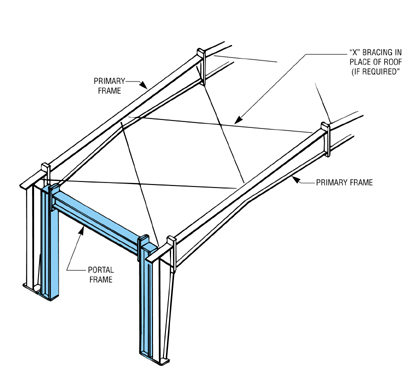

Portal Frame Bracing
The standard procedure to transfer longitudinal wind/seismic forces
from the eave line to the foundation is to utilize diaphragm action of
the wall sheeting and/or provide “X” rod (or cable) bracing in the sidewalls.
Should building requirements preclude the use of the standard procedure,
Ceco Buildings provide two alternate methods of bracing, one of which is
a Portal Frame system.
This system consists of rigid frames in the sidewall located between Primary Frames. The Portal Frame rafter is horizontal, with its top located 1’0” below eave height. All members of the Portal Frame are prismatic and are made of hot-rolled beam or welded-up H sections.
The number of Portal Frames provided in any sidewall will be as required by design. Portal Frames may be located in bays having “X” bracing in the roof (as illustrated) and/or in other bays as necessary to provide sufficient longitudinal bracing. The structural design of Portal Frames is based on a rigid connection between the Portal Frame columns and rafter and a pinned column base condition.
Portal Frame Bracing is designed to carry the entire longitudinal wind/seismic
eave line load without sharing any of this load with any other bracing
system.